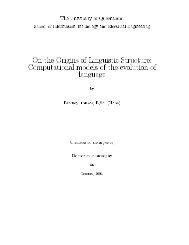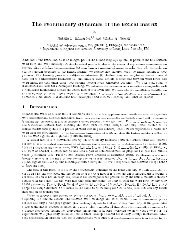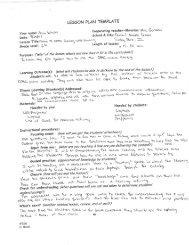Planning and Managing an Exhibition Programme
Planning and Managing an Exhibition Programme
Planning and Managing an Exhibition Programme
You also want an ePaper? Increase the reach of your titles
YUMPU automatically turns print PDFs into web optimized ePapers that Google loves.
with a highly<br />
re very limited<br />
d approach to<br />
; public.<br />
it is useful to<br />
rpressed either<br />
ice versa, how<br />
:r expressed in<br />
d in the latter.<br />
but also with<br />
s described in<br />
<strong><strong>an</strong>d</strong> m<strong>an</strong>aging<br />
; to employ in<br />
'ic densities<br />
nsity of closed<br />
;reatest variety<br />
ction in m<strong>an</strong>y<br />
in <strong>an</strong> existing<br />
nay have long<br />
ty for ongoing<br />
iponses to the<br />
lement of the<br />
s of evaluation<br />
. In this way a<br />
ile at the same<br />
fifteen years later. A well-pl<strong>an</strong>ned perm<strong>an</strong>ent collection display programme has<br />
assigned<br />
'expiry dates' for each gallery.<br />
This in turn c<strong>an</strong> only be done if a reasonable budget for exbibition reneual c<strong>an</strong>be<br />
projected with some confidence. The cost of exhibition renewal c<strong>an</strong> be projected on<br />
the basis of present exhibition costs, remembering of course that they are stated in the<br />
currency values of that year, <strong><strong>an</strong>d</strong> allowing for whatever enh<strong>an</strong>cements are proposed.<br />
Perm<strong>an</strong>ent collection exhibition renewal costs should be allocated as a budget item<br />
separate from the mainten<strong>an</strong>ce costs for the existing perm<strong>an</strong>ent collection displaS <strong><strong>an</strong>d</strong><br />
from the temporary exhibition budget. An amount c<strong>an</strong> be calculated in const<strong>an</strong>t<br />
currency as a percentage for <strong>an</strong>nual renewal - for inst<strong>an</strong>ce, a 20,000 ft2 (2,000 m2)<br />
gallery c<strong>an</strong> be projected for <strong>an</strong>nual renewal at a 1,0 per cent rate, me<strong>an</strong>ing that the cost<br />
of 2,000 ftz (200 m2) should be projected for each year of the exhibitiont intended<br />
over-all ten-year life expect<strong>an</strong>cy. This does not me<strong>an</strong> that a tenth of the exhibition must<br />
be ch<strong>an</strong>ged each year: rather, such a pl<strong>an</strong> might assume that in year 5 half of the gallery<br />
will be replaced, if half of the exhibits are pl<strong>an</strong>ned for only five years, or even that in<br />
year 10 the entire gallery will be replaced. The purpose of the pl<strong>an</strong> is to ensure that<br />
the funds are provided on <strong>an</strong> <strong>an</strong>nual incremental basis, so that the museum does not<br />
face a huge capital cost at the end of the exhibition's life sp<strong>an</strong>. Such long-r<strong>an</strong>ge budget<br />
provisions present challenges for public institutions with <strong>an</strong>nual return of funds to<br />
general accounts, but if possible a method should be found to provide for this kind of<br />
ongoing refreshment of the perm<strong>an</strong>ent collection displays.<br />
The following case study 8.1 describes the <strong>an</strong>alysis <strong><strong>an</strong>d</strong> subsequent display of the<br />
perm<strong>an</strong>ent collection of the Peabody Essex Museum in Salem, Massachusens in a<br />
particularly striking new exhibition called Odyssey that brought out the strengths of<br />
that museum's remarkable <strong><strong>an</strong>d</strong> varied collection.<br />
r first to pl<strong>an</strong><br />
rcy'. Too often<br />
t<strong><strong>an</strong>d</strong>ing ten or<br />
PLANNING AND MANAGING AN EXHIBITION PROGMMME







